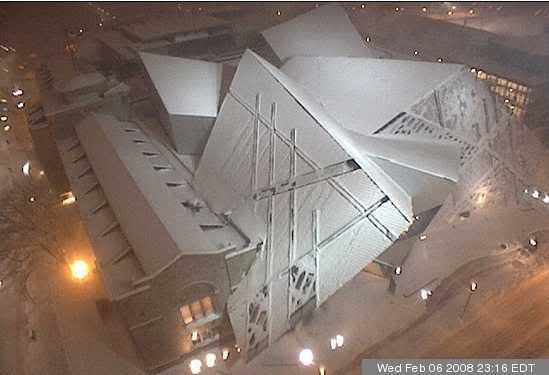And the Globe:
Potential crystallizes
Two new galleries in the ROM's Michael Lee-Chin Crystal mirror a cross-cultural connection
MICHAEL POSNER
From Wednesday's Globe and Mail
February 13, 2008 at 5:24 AM EST
Piece by ancient piece, gallery by state-of-the-art gallery, the Royal Ontario Museum is moving to realize the exhibition potential of its new addition - the Daniel Libeskind-designed Michael Lee-Chin Crystal.
Late last year, it opened its first exhibits in the new wing, featuring its collections of dinosaurs and mammals. Attendance at the Toronto museum has more than doubled in the weeks since.
Yesterday, for invited guests and the press, it unveiled two new galleries, devoted respectively to South Asian and Middle Eastern culture. They seem destined to keep the crowds coming.
Modest in size, manageable in terms of viewing time required, the new Sir Christopher Ondaatje South Asian Gallery and the Wirth Gallery of the Middle East temporarily occupy the same third-floor space, a physical linkage that mirrors their cross-cultural connections. Their creation allows the ROM to display many priceless items too long confined to the building's storage areas.
As the ROM's CEO William Thorsell reminded yesterday's audience, it was only six years ago that the institution had approached financier Christopher Ondaatje to contribute $1-million to fund a predecessor South Asian space. He had agreed, subject to matching donations from the South Asian community and the ROM itself.
"Within a year, I had to turn around and say, 'Christopher, we want to take your gallery apart and rebuild it in a new building that has yet to be designed.' But he kept the faith."
On hand for the opening, Ondaatje, the Sri Lankan-born businessman, adventurer, writer and philanthropist (brother of author Michael Ondaatje), said the galleries were evidence of the success of Canada's multicultural experiment. "Canada is the great united-nations experiment and it works. People are not fighting here. People come here, they start again and you can do anything here, absolutely anything."
The 4,052 square-foot Wirth Gallery is named for philanthropist Alfred Wirth, founder of investment counsellors Wirth Associates, who also sits on the museum's board of governors. He donated $2.5-million. "I like everything that's old," Wirth said with a laugh.
The Middle Eastern gallery, which includes artifacts from the Paleolithic age to the 20th century, is organized by themes. Perhaps the oldest object on display is a quartzite tool used in Egypt at least 1.4 million years ago, used for chopping. But the exhibit, curated by Warsaw-born and trained Krzysztof Ciuk, also features an extraordinary Iraqi Torah dating from about 100 years ago and a Babylonian glazed-brick wall relief that once adorned the palace of Nebuchadnezzar, about 600 years before the birth of Christ.
Ciuk said his favourite piece is an 18th-century Turkish musket from the sultan's armoury but with a French-designed and manufactured lock and barrel. "Somebody went to a lot of trouble to make this. But it's a gentleman's piece, used as a hunting weapon, not in warfare."
Not yet hung are two huge maps of the region, based on GPS projections.
Does the gallery meet all of Ciuk's ambitions? "Well, one is never fully satisfied, but I would call it a small pearl."
The Ondaatje Gallery includes dozens of stunning pieces, including an untitled modern life-size carving by Mumbai-based artist Navjot Altaf of a seated "goddess" woman, made from teakwood and painted blue, the traditional colour of the East Indian gods.
"The whole piece seems to be having a dialogue between East and West, between what is modern and what is traditional, between the hand-crafted and the industrial," explained Deepali Dewan, who curated the South Asian space. New Delhi-born and of mixed East Indian and American origins, Dewan did her undergraduate work at Montreal's McGill University, "so I kind of feel Canada keeps calling me back. And I came because I knew the renovation project was going on and that I'd have the opportunity to curate the gallery."
The Altaf sculpture was one of several purchased by Dewan from a $1-million acquisitions budget catalyzed by the Louise Hawley Stone Charitable Trust.
About 400 of the gallery's 6,000 South Asian objects are on display, "a better proportion than most museums," she explained. "But not all objects need to be seen. You have redundancies or things not in great condition. And on-line service and published catalogues can get the rest of it out."
My only criticism is the same one that applies to many museums - insufficient labelling. I To maximize the experience, museum-goers need much more information about the history, provenance and meaning of the works on display, both via audio and print technologies.
The ROM's two new galleries open to the public on Saturday.
AoD
